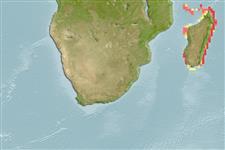Common names from other countries
>
Eupercaria/misc (Various families in series Eupercaria) >
Sciaenidae (Drums or croakers)
Etymology: Argyrosomus: Greek, argyros = silvered, silver + Greek, soma = body (Ref. 45335).
More on author: Lacepède.
Environment: milieu / climate zone / depth range / distribution range
Ecologie
marien; zoet water; brak water demersaal; diepte ? - 400 m (Ref. 27121), usually 15 - 150 m (Ref. 27121). Subtropical; 13°C - 24°C (Ref. 3593); 11°N - 27°S, 43°E - 51°E
Indian Ocean: endemic to Madagascar (Ref. 11025). Reports from "Ghana to South Africa" (Ref. 57396) refer to Argyrosomus regius and Argyrosomus coronus (Ref. 11025).
Grootte / Gewicht / Leeftijd
Maturity: Lm ? range ? - ? cm
Max length : 200 cm TL mannelijk / geslacht onbekend; (Ref. 4336); common length : 100.0 cm SL mannelijk / geslacht onbekend; (Ref. 9772); max. gepubliceerd gewicht: 71.0 kg (Ref. 5369); max. gerapporteerde leeftijd: 30 Jaren (Ref. 12198)
Dorsale stekels (totaal) : 11; Dorsale zachte stralen (totaal) : 26 - 30; Anale stekels: 2; Anale zachte stralen: 7. Body silvery; fins grey or brown; upper end of pectoral base with a black blotch (Ref. 4373).
Found in lower reaches of rivers, estuaries, rocky reefs, ocean beaches and on the continental shelf down to 150 m (Ref. 9772). Caught near the bottom and in mid-water. Feed mainly at night or in turbid waters (Ref. 27121), preying on cuttlefish (Ref. 27121), fishes, crabs, prawns, and worms (Ref. 9772).
Levenscyclus en paargedrag
Maturities | Voortplanting | Spawnings | Egg(s) | Fecundities | Larven
Chao, L.N. and E. Trewavas, 1990. Sciaenidae. p. 813-826. In J.C. Quero, J.C. Hureau, C. Karrer, A. Post and L. Saldanha (eds.) Check-list of the fishes the eastern tropical Atlantic (CLOFETA). JNICT, Lisbon; SEI, Paris; and UNESCO, Paris. Vol. 2. (Ref. 3593)
Status op de Rode Lijst van het IUCN (Ref. 130435)
CITES (Ref. 128078)
Not Evaluated
Gevaar voor de mens
Harmless
Gebruik door de mens
Visserij: commercieel; sportvis: ja
Tools
Speciale rapporten
Download XML
Internetbronnen
Estimates based on models
Preferred temperature (Ref.
115969): 21.4 - 27.6, mean 25.9 (based on 60 cells).
Fylogenetische diversiteitsindex (Ref.
82804): PD
50 = 0.5020 [Uniqueness, from 0.5 = low to 2.0 = high].
Bayesian length-weight: a=0.00562 (0.00332 - 0.00953), b=3.06 (2.92 - 3.20), in cm Total Length, based on LWR estimates for this species & (Sub)family-body (Ref.
93245).
Trofisch niveau (Ref.
69278): 4.5 ±0.8 se; based on diet studies.
Weerstandsvermogen (Ref.
120179): Zeer laag, minimale populatieverdubbelingstijd meer dan 14 jaar (K=0.03; tm=6).
Fishing Vulnerability (Ref.
59153): Very high vulnerability (90 of 100).
Climate Vulnerability (Ref.
125649): Moderate to high vulnerability (53 of 100).
